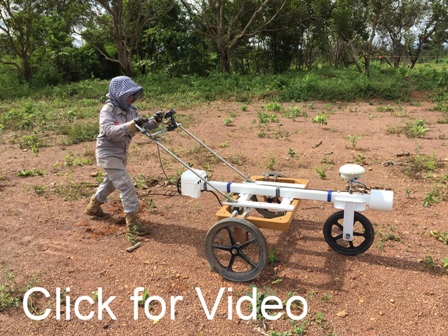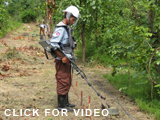





 |

Kosovo is contaminated by landmines and explosive remnants of war (ERW), primarily as a result of the conflict between the Federal Republic of Yugoslavia (FRY) and the Kosovo Liberation Army (KLA) in the late 1990s and the conflict between the FRY and NATO in 1999.
Mine contamination: The 2020 Land Mine and Cluster Munitions Monitor reports that 49 mined areas covered 1.6km2 as of the end of 2017. This is a reduction from 58 areas reported the previous year. Contamination includes anti-personnel (AP) and anti-vehicular mines. Many of the AP mines are low metal content, making detection difficult. Additionally, most of the minefields are only a few meters away from occupied houses.
Mines are found mainly on Kosovo`s borders with Albania and Macedonia but also in the area of Dulie Pass in south-central Kosovo. The mines inhibit agriculture, pasture, tourism, infrastructure development and collection of firewood. The rural poor are affected the most.
Cluster munition contamination: Contamination from cluster munition remnants in Kosovo covered 49 areas covering 15.4km2 at the end of 2017, compared to 53 areas over 15km2 at the end of 2016. Three areas containing cluster munition remnants were released during 2014. NATO aircraft dropped 1,392 bombs that released 295,700 submunitions during Operation Allied Force. Forces of the FRY also used cluster munitions during the conflict. Submunitions are often found in close proximity to places where people live and work.
The HALO Trust is conducting operational field evaluations with two US Humanitarian Demining Research and Development (HD R&D) Program detection technologies in Kosovo; the Handheld Standoff Mine Detection System (HSTAMIDS) since April 2016 and the Scorpion unexploded ordnance (UXO) Detection System which began in late 2020.
Sources: To Walk the Earth in Safety, 2023
Landmine Monitor Report, 2020
|
|
Scorpion |

|
Scorpion is a man-portable unexploded ordnance (UXO) detection system that utilizes a one meter wide electro-magnetic induction (EMI) sensor and a total field magnetometer to detect buried UXO objects in an overpass mode. The system uses differential global positioning system (DGPS) to provide centimeter accuracy of target locations and mapping capability.
Distribution Statement A: Approved for public release.



PARTNERS: Golden West Humanitarian Foundation - Cambodia 2012; Mines Advisory Group - Cambodia; Norwegian People`s Aid - Vietnam, The HALO Trust - Afghanistan, Kosovo
|
|
HSTAMIDS |

|
The Handheld Standoff Mine Detection System (HSTAMIDS) is the U.S. Army`s AN/PSS-14 dual sensor, handheld mine detector that combines an electromagnetic induction sensor and ground penetrating radar (GPR) to detect landmines. The addition of the GPR significantly reduces the detector`s false alarm rate and the time the operator spends investigating clutter, increasing the operator`s speed and effectiveness. The HD R&D program also developed the HSTAMIDS F3S variant which incorporates a more sensitive metal detector to improve performance against deeply buried low metal anti-personnel and anti-tank mines.
Distribution Statement A: Approved for public release.



PARTNERS: The Halo Trust in Afghanistan, Cambodia, Mozambique (2012-2014), Kosovo,Sri Lanka and Zimbabwe; Mines Advisory Group in Angloa and Cambodia; Cambodia Mine Action Centre (2009-2010); Norwegian Peoples Aid in Zimbabwe (2014-2016)
|
|
    
|
|

